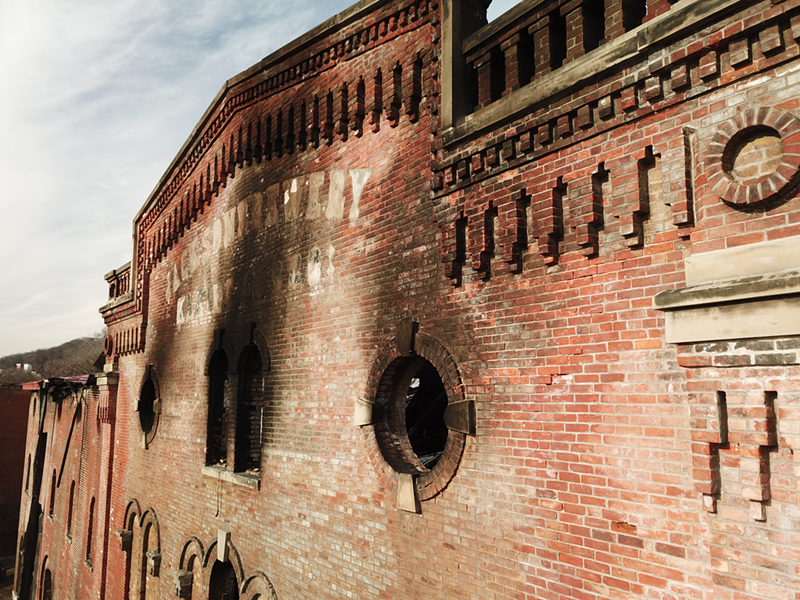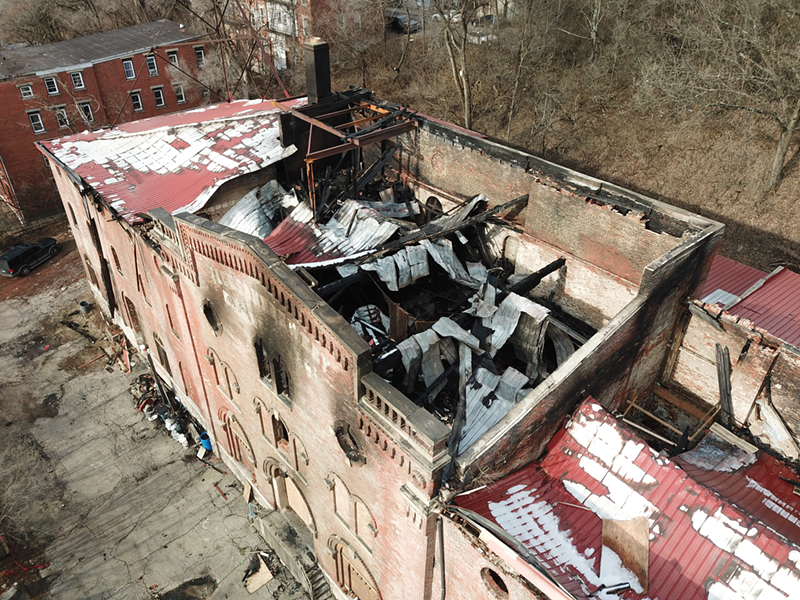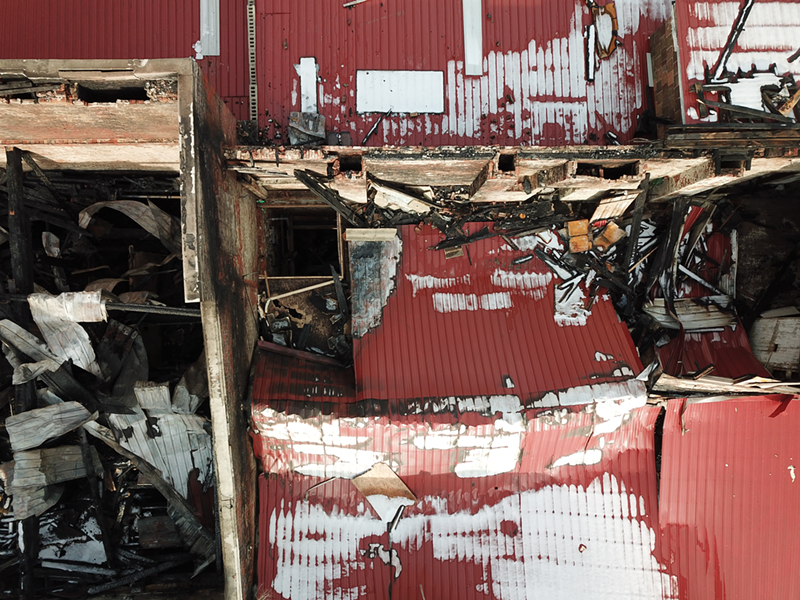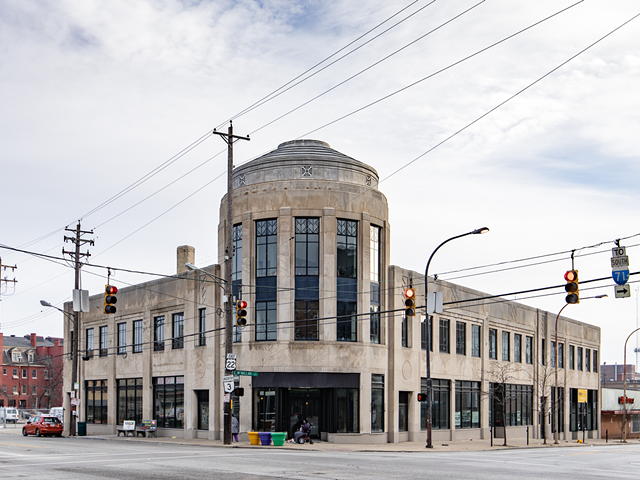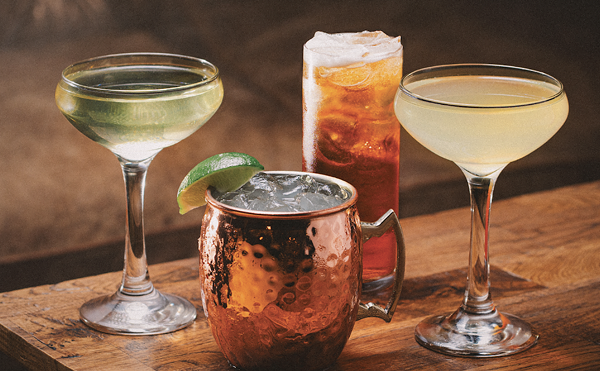The Jackson Brewery, a castle-like edifice lording above Over-the-Rhine at the nexus of Elm and Mohawk streets, is the vestige of more than 170-years of unbreakable tenacity, a history of heroism, narcissism, bad ideas, a little criminality and a lot of stubborn hope. Ravaged by fire in December 2019 — an alleged act of arson that caused a reported $500,000 in damages — the fate of the Jackson Brewery building now hangs in the balance, a looming test of Cincinnati’s dedication to preserving our storied brewing history.
According to legend, George Schmelzer built the brewery in 1829, but booze history often suffers from fuzzy recollections. (Schmelzer didn’t buy the land until 1845, so this date is probably exaggerated.) In truth, brothers Meinrad and Fridolin Kleiner gave the Jackson Brewery its name and built the brewhouse that now stands in peril.
The Kleiner family ran their own brewery in Prussia (later part of Germany) for 150 years before the German Revolution of 1848, when Meinrad got involved in politics. During the revolution, there was a mostly peaceful shift in power that temporarily unified the German states as one democratic government until the right-wing systematically reestablished control. By the end of 1849, the brewery and the family’s assets were seized by a reinstated autocracy in retribution for Meinrad’s progressivism, and the brothers set off for the U.S. as “Forty-Eighters” — German immigrants that left the Fatherland as a result of the counter-revolutions.
Landing in New Orleans broke, Meinrad took a job as a waiter, but by 1854 the brothers had united in a new business venture in Cincinnati. They purchased the brewery at the head of Elm Street and renamed it “Jackson.” Although best known today for his starring role on the $20 bill and his accomplishments as a ranting, genocidal sociopath, Andrew Jackson was better known in the 19th century as the symbol of populist, working-class democracy — the same basic ideologies that had gotten the Kleiners booted out of Prussia.
The brothers prospered, but five years into their ownership, the Jackson Brewery was gutted by fire. They immediately rebuilt, but they also began purchasing the hillside above the original brewery to build the larger, better brewhouse that stands today (finished circa 1865 despite what other sources say.)
Under the Kleiners’s tutelage, Jackson became one of the city’s largest and most respected breweries. Then, Fridolin Kleiner died in 1869 and Meinrad followed four years later. Meinrad’s demise was called “wholly unexpected” at the time, but it’s not much of a medical mystery. He was President of the “Independent Order of Fat Men of Cincinnati,” a group of obese gentlemen who enjoyed getting together, getting hammered and celebrating their girth.
The Kleiner heirs sold the brewery to George Weber, a flamboyant narcissist. Weber was rich — at least that’s what he said. But Weber was a liar. He only put $1 down on the brewery and financed the rest by relying on his reputation as a wildly successful businessman — a reputation that was premised entirely on his own bullshit.
Weber immediately slapped his own name on the brewery, then went about the work of wrecking the business. He quickly alienated his fellow brewers, had debilitating cash-flow problems and had to seek court protection from creditors within eight months.
Bankruptcy did nothing to humble him. He continued to insult fellow brewers and battle with creditors and the court-appointed trustees who were making the business solvent again. Weber’s wars reached a crescendo when a battle erupted over physical control of the Jackson Brewery. Weber loyalists took over the office early one morning, barred the doors and fired the men who were loyal to the competent court-appointed trustees who, in turn, rallied the newly unemployed to storm the brewery and take back control. In the melee that followed, foreman William Gerst tried to throw a brewer into a furnace.
Ultimately, Weber won the battle and Gerst lost his job — as a result of his loyalty to the trustees rather than for attempting to murder a co-worker. With the backing of Christian Moerlein, Gerst went on to purchase the Nashville Brewery. (As the Gerst Brewing Company, it became the flagship brewer of Nashville. So, Nashville, you’re welcome, and thanks for the chicken.)
Greed and another fire sunk Weber. After employing various acts of fraud to pay off the brewery’s debts, Weber was briefly reinstated as the principal owner of the business before quickly driving it off the first financial cliff available. A new partner bailed him out, and Weber rewarded him by running up debts the partner didn’t know about. Then, when a Roman Candle ignited the brewery’s malthouse at 12th and Clay streets on July 4, 1887, resulting in a massive fire that killed two people, the under-insured Weber couldn’t survive. He was finally forced out of the business and took a job at a hotel, where he later died of a heart attack on the job.
The Jackson Brewery — restored to its proper name — recovered from Weber’s reign and moved on.
When Prohibition descended on Cincinnati, Jackson was busted in the first major raids conducted by federal agents in 1920. Brewery officials paid a fine, reopened and Jackson lived on to also be the last Cincinnati brewery to face Volstead violations in December 1928. The feds brought criminal charges against brewery executives and the Treasurer of the State of Ohio in a conspiracy that implicated Ohio’s Governor and a senator. Brewery officials went to jail and the Jackson Brewery finally closed in 1929. Reopening after Prohibition in 1933, it ran into immediate financial problems, was sold in 1934, faltered for a while and closed in 1943. No beer has been brewed in the building since.
The Jackson Brewery lost its identity over the years, eventually falling into vacancy and disrepair. It was then purchased by architect Denny Dellinger in 2001. He says that when he first experienced the building’s grand enormity, he thought, “I have to be able to do something with this.”
Dellinger cordoned off a single room in the massive structure and lived there like the last member of some dethroned royal family keeping a light burning until the rightful heirs return. He relied on a small wood stove to survive winters. Dellinger’s dogs kept him company and acted as security, backed up by a shotgun under his cot. The situation didn’t inspire Better Homes & Gardens to come calling for a feature, but looking back, Dellinger still says that “it was glorious.”
Dellinger was forced to part ways with the building in 2007. As one of the founding members of the Brewery District Community Urban Redevelopment Corporation, he helped spark interest in north Over-the-Rhine, and he owned the building when the city’s first brewery tours showcased Jackson’s massive lagering cellars in 2006.
A lot has changed in the intervening years. When the Kleiner brothers bought the brewery, the city was in the midst of an unprecedented growth in the industry. Greater Cincinnati’s less than a dozen breweries grew to a peak of 36 between 1850 and 1860. The Jackson Brewery bore witness to a similar growth in recent years. Thanks in large part to the Brewery District’s pioneering work, Cincinnati has a growing heritage tourism business, one in which the Jackson Brewery still plays a prominent role.
Steve Hampton, executive director of the Brewery District C.U.R.C., states that the next phase of the multi-million-dollar Brewing Heritage Trail — an immersive self-guided history tour that opened in April 2019 and of which I am a curator — will include Jackson. Hampton notes that the building is one of the region’s historic jewels. Built in the Rundbogenstil style, a specifically German version of Romanesque Revival architecture, the Kleiner brothers may have chosen the design as a bitter-tinged tribute to the family brewery that they were forced to leave. Today, “Jackson Brewery Kleiner Bros” is still spelled out in stone at the top of the damaged façade.
On the morning following the December fire at Jackson, media reported Cincinnati firefighters had declared the building a “total loss” after the roof collapsed, and there was gossip some in the city meant to finish the work of the alleged arsonist and raze the historic brewery. However, Fred Berger, the building’s current owner, pushed back, and the community rallied behind the cause of saving the Jackson Brewery for future development. With the help of several Cincinnati City Council members and City Manager Patrick Duhaney, Berger and the community appear to now be engaged in a conversation about the options ahead.
When Berger purchased the building in 2012, it was primarily a liability. After decades of neglect, the roof was unsound, and structural walls were of questionable integrity. He says he bought the building out of a love for Cincinnati history and a desire to save the Jackson Brewery from a slow demise. Over the past five years, he says he spent hundreds of thousands of dollars of his own money on masonry, roof and structural repairs. This work is largely attributed to why the building was able to withstand the December conflagration and remain structurally sound, for now. It is extremely difficult to insure a vacant building, so Berger didn’t have a casualty policy. Most of the money he has invested in Jackson’s renaissance went up in flames.
Jackson Brewery’s next chapter — like the future of the city’s rapidly evolving beer business itself — remains uncertain. Some members of the Brewery District have discussed raising money for a revolving loan fund that could be used to assist the restoration of Jackson, then provide friendly and flexible terms to subsequent restoration projects. Preservation revolving loan funds have been successful in other cities for decades.
Berger describes himself as “just a caretaker” of the Jackson Brewery, a short moment in a long, rich and twisted history. Generations before and ahead all hang in the balance, and however Berger decides to move forward from the latest adversity to face the Jackson Brewery, the project is going to need the help of a city that has developed a renewed pride in its brewing heritage. Jackson will either be lost to fire or saved by the city around it.
Michael D. Morgan is the president of Queen City History and Education; a curator of the Cincinnati Brewing Heritage Trail; author of Cincinnati Beer and Over-the-Rhine: When Beer Was King; attorney; and adjunct professor at the University of Cincinnati.

